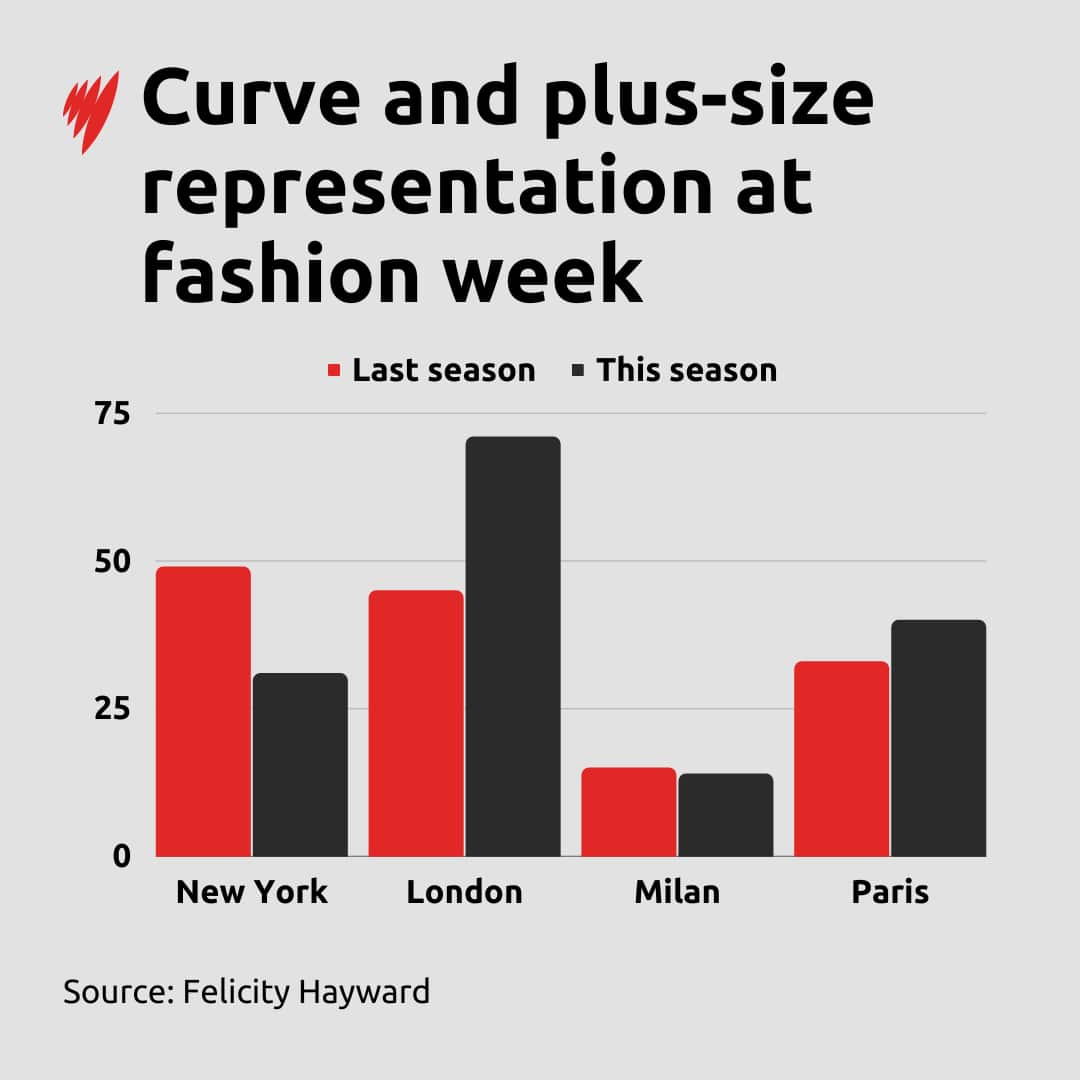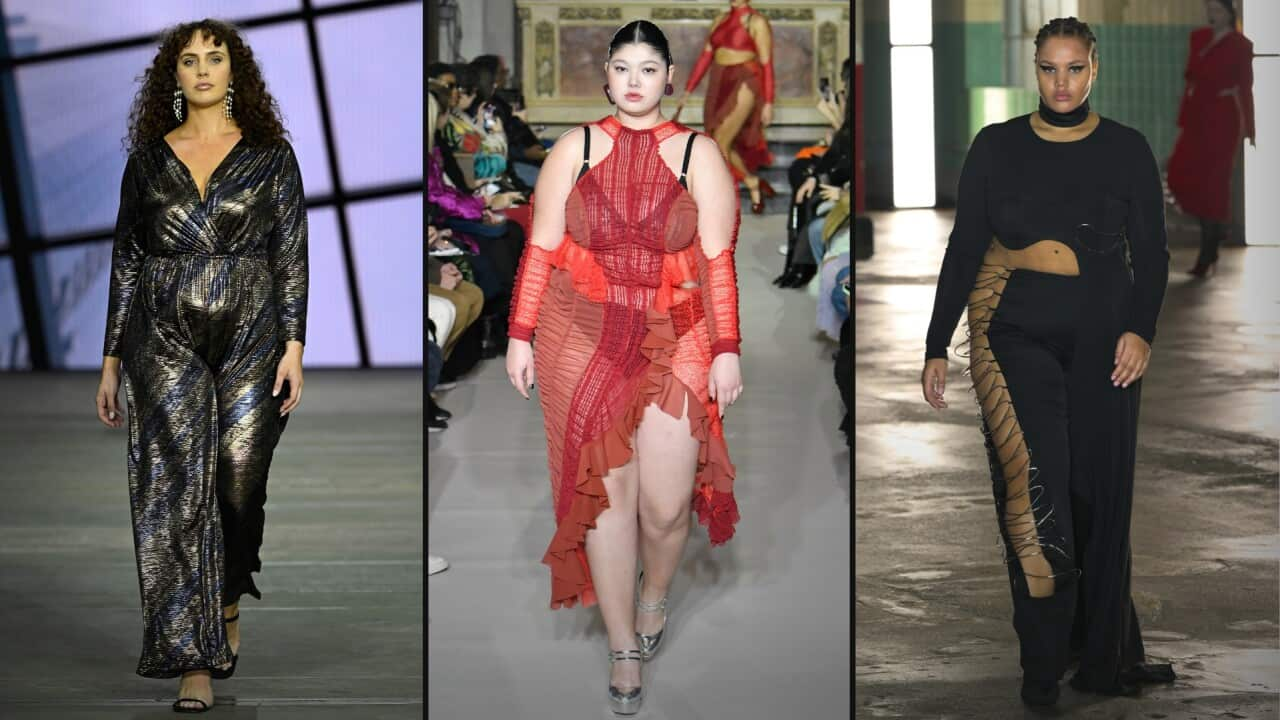Key Points
- The fashion industry has embraced all kinds of diversity in recent years, including size.
- Some fear those gains are being lost after a reduction in curve and plus-size models at major fashion weeks.
- Melbourne Fashion Festival is among the events being criticised for its lack of size inclusivity.
There has been a noticeable increase in size diversity in the fashion world over the last decade, with models once deemed "too big" for haute couture walking for high-end labels, gracing the covers of magazines, and becoming the faces of major campaigns.
"It was going really well," Australian-born model and activist Jennifer Atilémile told SBS News.
"We were making such good progress with all kinds of inclusive conversations."
But the 31-year-old is among a growing number of people concerned that the fashion industry is once again becoming more exclusionary, especially when it comes to size.
"I've felt the conversation shifting for a while, and it's something that amongst my peers we've been quite vocal with each other about," she said.

Jennifer Atilémile is an Australian-born model and activist. Source: Instagram / Jennifer Atilémile
"I remember having conversations with both of my agencies in America and in London, and I just said, 'I have a really bad feeling, like, I think this is going the other way'," she said.
"They all assured me that it wasn't. Now they have kind of backtracked on that."
According to analysis by British model, activist and author Felicity Hayward, there was a decrease this season in the number of 'curve' and 'plus-size' models — that is, those who wear above a size 10 — used across two of the "Big Four" fashion weeks.
While New York Fashion Week had historically been the industry leader when it came to size inclusivity, just 31 of the more than 3,000 models to feature in catwalks for AW23 were considered curve or plus size. Last season, there were 49.
Milan, which has always been at the back of the pack, also regressed, while gains were made in London and Paris.

How does Australia compare?
For a long time, wasn't even willing to have a conversation about size inclusivity, Ms Atilémile said.
"I often say that Australia's 10 years behind everyone else," she said.
"But last year, they were probably the most inclusive country doing fashion weeks."
That was due in part to the efforts of BELLA Management chief executive and former model Chelsea Bonner, who has been pushing for greater size inclusivity in the Australia fashion industry for decades.
Ms Bonner was so sick of not seeing a diverse range of bodies featured on the catwalk that she decided to produce and self-fund a show at Australian Fashion Week (AFW) called The Curve Edit.
"I had finally just absolutely cracked it because I could see what was coming through ... I know which designers are going to be open to using different sizes and the ones that aren't and I thought, 'It's just not going to get done again'," she told SBS News.

The Curve Edit featured models of different shapes and sizes. Source: Getty / Caroline McCredie
Larger models like Ms Atilémile, who wears an Australian size 12-14, also walked in shows for labels that typically wouldn't use anyone above a sample size.
"I don't think extending to an Australian, say, 16 is enough, but it was exciting to see more brands embrace extended size ranges," she said.
Given that progress, Ms Bonner said she was disappointed to see size diversity wasn't embraced by Australia's most recent major fashion event, .
"I think they've moved the needle backwards several decades this year," she said.
"I felt like I was watching 1982 again. It was just boring, old, elitist boardroom members who decided they'd show us what real fashion is, and failed miserably."
Ms Bonner said her agency had been "really active" in the lead up to MFF, pushing for more models above a size 10 to be included in the festival's main runways, but their emails were ignored.
"It was just so obviously a casting direction that they had chosen to take, because it's not for lack of information," she said.
"We know that 67 per cent of Australian women are size 14 to 16, and the rest of the population is either over size 16, or between a size 10 and a size 12.
"The models on that runway represent 1 per cent of the population. That is insane on every level."

Chelsea Bonner is chief executive of BELLA Management and a former model. Source: Instagram / Chelsea Bonner
In a statement, a MFF spokesperson said 10 of the festival's premium runways featured "curve talent". They did not specify how many individual curve models were used across those 10 runways or what size clothing they wear.
"Across our program, the festival showcased a broad range of models, from size six through to size 24, working with leading casting and modelling agencies to ensure a strong representation of curve talent," the spokesperson told SBS News.
"In addition, the festival played host to many events that had the specific purpose of promoting awareness and support for size inclusivity."

Rani West, a size 14 model represented by BELLA Management, was among the curve models to walk at this year's Melbourne Fashion Festival. Source: Getty / SOPA Images
The show's producer Lucy Wilkins said given the conversations happening in fashion about size right now, the timing couldn't have been better.
"Seeing that only thin people are fashionable is really damaging," she told SBS News.
"With our runway, because it was all about not just fat representation but POC and queer representation, everyone felt welcomed and included."

Source: Supplied / Laura Du Ve
"I think they (MFF) do use the Fashion Culture program — which is all self-funded, self-produced shows — to make themselves look like they're more inclusive than they are," she said.
"I went and saw one of their big runways, and there was one curve model who was maybe a size 14, if that, and that was it, that was our representation."

Lucy Wilkins is a Melbourne-based fashion designer. Source: Instagram / Lucy Wilkins Fashion
"We all have money to spend, we all want to wear nice things, it's just not being offered to everybody," she said.
"I'm hoping that it's going to be this little blip in time that we're like, 'Whoa, what were we doing? That's so bad', because it is really bad right now."
But she said in order for that to happen, "everybody needs to be having this conversation".
"When people that aren't directly affected start to speak up about these things, that's when other people might think, 'Hang on, maybe there's something to be fixed'."
Readers seeking support for body image concerns and eating disorders can contact Butterfly Foundation on 1800 33 4673. More information is available at

